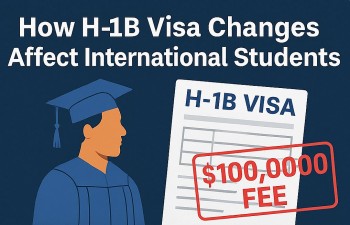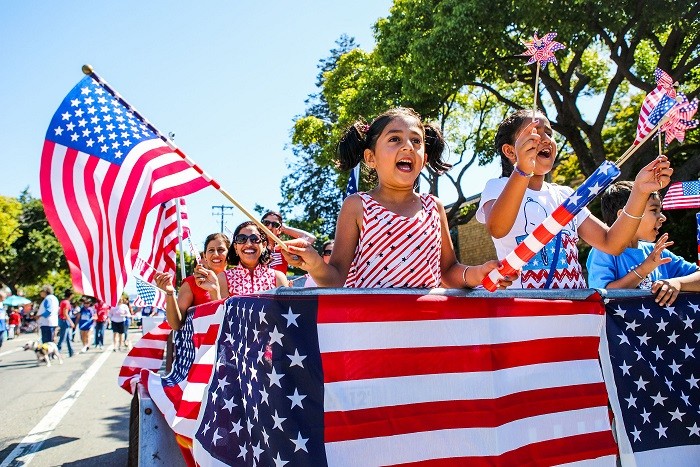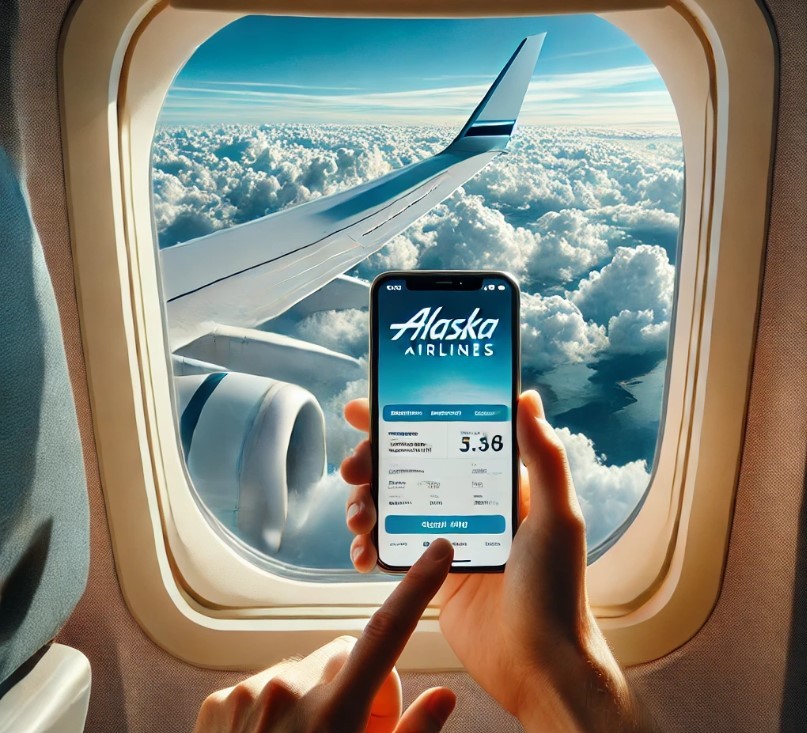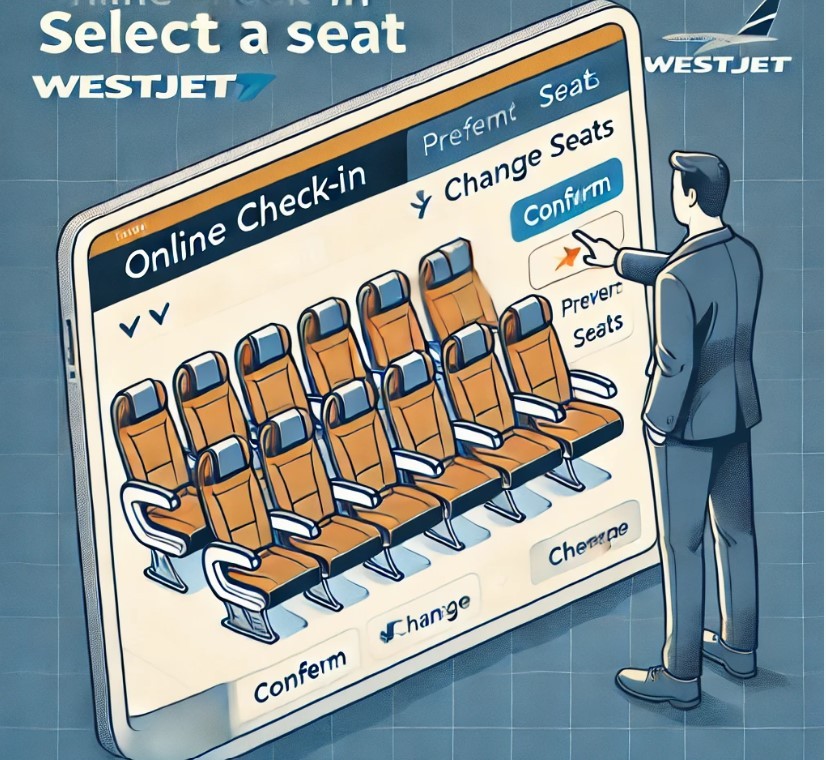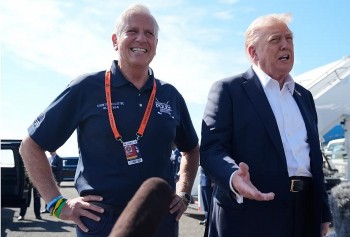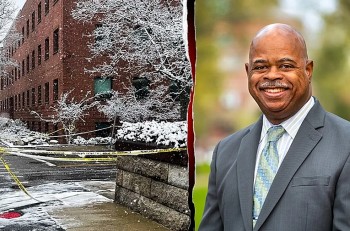H-1B Visas Under Trump: Stricter, Faster, and Paving a Path to Citizenship
Under the Trump administration, immigration policy for high-skilled workers is undergoing a major transformation. DHS Secretary Kristi Noem claims the process has been sped up, made more secure, and is leading to a record number of people becoming U.S. citizens. But behind the bold rhetoric lie stricter rules, massive employer fees, and rising competition. For tech workers, researchers, and employers relying on H-1B visas, the landscape is no longer what it was—even a year ago.
This article breaks down what’s changing, what it means in practice, and how both employers and immigrants can stay ahead of the curve. From new rules on salary-based lotteries to the $100,000 visa fee and green card strategy, we lay out exactly how to navigate the system step by step—under this new era of “faster but tougher” immigration.
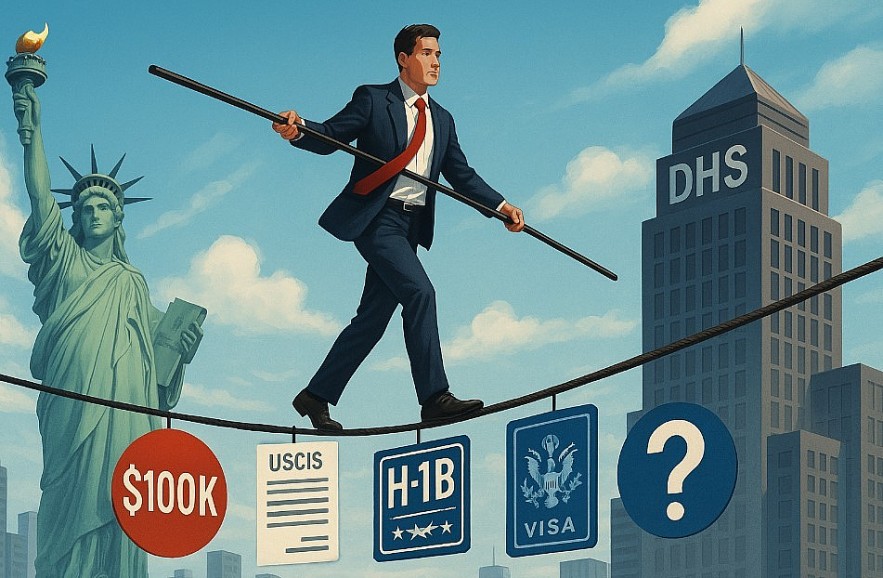 |
| H-1B Tightrope |
1. What is the H‑1B visa programme? A refresher
The H‑1B visa category is a key non‑immigrant visa classification that allows U.S. employers to hire foreign nationals in “specialty occupations” — typically roles requiring a bachelor’s degree or higher in a defined field (for example in STEM, business, or other specialised professions).
Historically:
-
Congress set an annual cap (for many petitioners) of 65,000 visas, with an additional 20,000 reserved for foreign nationals holding U.S. master’s degrees or higher.
-
Applicants generally go through a lottery if petitions exceed the cap.
-
H‑1B status can be granted initially for up to three years, with a possible extension to six years (and longer in certain green‑card pending cases).
-
Many H‑1B holders use the status as a stepping stone to employment‑based green cards (adjustment of status) and ultimately to U.S. citizenship (naturalisation).
Thus the H‑1B remains an important bridge between temporary high‑skilled work and longer‑term immigrant status.
2. Secretary Noem’s comments: what they signal
In her remarks, Secretary Noem emphasised three central themes:
A. Speed and integrity of processing. She claimed that under the Trump administration the process for visas, green cards and related immigration pathways has been sped up and made more secure. The implication is a shift away from earlier backlogs, delays and what were viewed as vulnerabilities in the system.
B. More people naturalised than ever. She stated that more people are becoming U.S. citizens than at any prior time under this administration. While exact statistics were not included in her comment, it emphasizes a priority on naturalisation.
C. Continued commitment to H‑1B (and green‑card) programmes — but with more rigorous criteria. Specifically, she noted that H‑1B holders must, for example, “meet some criteria that are very important for those coming to the country”, including not supporting terrorist groups or anti‑American organisations, and arriving for the “right reasons”.
Taken together, these remarks suggest that the administration sees high‑skilled immigration as important — but only under tighter governance of the process.
3. Contemporary policy environment: major recent changes
To understand how these comments fit into policy, we must review current major reforms and proposals affecting the H‑1B programme and related immigration channels.
3.1 $100,000 employer fee and Entry Restriction
A major development: On 19 September 2025, a presidential proclamation declared new rules for the H‑1B programme. The key points:
-
A one‑time employer payment of US$100,000 for each new H‑1B petition filed on behalf of a foreign worker outside the U.S., effective after September 21, 2025 (subject to exceptions).
-
The restriction applies to petitions for aliens outside the U.S. under the H‑1B category, absent an exception.
-
The Secretary of Homeland Security retains discretion to exempt an industry, company or individual if the hiring is determined to be “in the national interest” and “does not pose a threat to the security or welfare of the U.S.”
3.2 Proposed H‑1B lottery reforms and salary weighting
In recent months, the Consumer Technology Association and higher education groups have commented on rule‑making by the Department of Homeland Security (DHS) proposing to change the H‑1B lottery system to give weighting to higher wages. For example:
-
A proposal envisions a “wage‑based” lottery (or hybrid) so that higher paid roles get priority.
-
Many higher‑education and advocacy groups have raised concerns that early‑career professionals or smaller employers may be disadvantaged.
3.3 Exemptions & special industry concerns
-
Higher education institutions are lobbying for exemptions from the $100,000 fee and other constraints, arguing that H‑1B hires in research, teaching and health professions fulfil national interest.
-
The American Medical Association and allied groups specifically urged DHS to exempt physicians (including foreign‑trained) from the new fee because of the workforce shortage in underserved areas.
3.4 Emphasis on naturalisation and green cards
While the primary structural reforms focus on nonimmigrant visas, Secretary Noem’s emphasis on “more people becoming citizens” signals a parallel policy drive to move holders of green cards and other eligible residents into U.S. citizenship. It also suggests that processing of green‑card adjustment and naturalisation adjudications may receive heightened resources (or priority) under the current administration.
3.5 Enforcement and eligibility criteria
As noted in Secretary Noem’s remarks and media coverage, DHS is emphasising stricter eligibility for H‑1B and related immigration pathways: criteria around national security, visa‑fraud prevention, employer compliance, and ensuring H‑1Bs supplement rather than replace U.S. labour.
4. Interpretation: What the changes mean in practice
For employers, visa‑holders and prospective immigrants, the above policy landscape translates into several practical implications.
4.1 For employers seeking H‑1B hires
-
Higher cost & uncertainty for new hires outside the U.S. The $100,000 employer fee significantly raises the cost of obtaining a new H‑1B from abroad, unless the employer secures a national‑interest exemption from DHS. This may discourage some filings or shift strategy toward hiring foreign nationals already in the U.S. under other statuses.
-
Greater scrutiny of employer‑beneficiary relationship and prevailing wage/pay structure. With proposed wage‑based weighting and increased regulatory attention, employers will want to ensure that job offers meet prevailing wage requirements, that the role is genuinely a “specialty occupation,” and that the relationship is properly documented.
-
Potential shift in preference or selection toward higher wage roles. The wage‑based lottery proposals indicate that roles offering higher compensation may be favoured, so employers of entry‑level or lower‑wage specialty occupations may face more difficulty.
-
Need to build compliance and documentation. Employers should bolster labour‑condition application (LCA) compliance, maintain records of worker wage, job duties, employer‑employee relationship, and be ready for DHS or DOL audit or inquiry.
-
Alternative pathways or exempt categories may become more attractive. For example, hiring foreign nationals already in the U.S. (change of status) rather than abroad; or exploring categories exempt from cap or from the new fee; or investing in green‑card sponsorship sooner.
4.2 For H‑1B visa beneficiaries or prospective applicants
-
If already in the U.S. on another status (F‑1, OPT, J‑1, etc.), work with employer about “change of status” vs consular processing. Some of the new fee/entry restrictions apply specifically to workers outside the U.S.
-
Be aware of wage/salary implications. If employers are increasingly prioritised by wage, being hired into a higher‑wage role may improve the likelihood of selection—and strengthen your case.
-
Understand the risk of abandonment or denial if employer compliance is weak. DHS’s emphasis on integrity means visa holders must ensure the role aligns with what was petitioned, the employer‑employee relationship exists, and changes are timely addressed.
-
Think ahead about green‑card and citizenship pathways. Given the administration’s stated interest in boosting naturalisation, visa holders should work early with immigration counsel on timing, eligibility and strategy for permanent residence and eventual naturalisation.
-
Maintain clean records and eligibility. Given the emphasis on “right reasons” and national interest in Secretary Noem’s remarks, beneficiaries must ensure compliance with the law, avoid disqualifying conduct, and maintain valid status.
4.3 For institutions and foreign‑trained professionals in research, academia or health care
-
Advocacy around exemptions is active. Higher‑ed institutions and health care organisations are pressing DHS to carve out exemptions from the $100,000 fee and other restrictions for roles deemed in the national interest (faculty, researchers, physicians).
-
If you qualify under an exemption, document and prepare accordingly. If your role (e.g., tenured faculty, researcher) may qualify for national‑interest exemption, gather documentation early: job description, national‑interest justification, salary levels, etc.
-
Understand how changes in H‑1B rules may impact recruitment. With higher employer costs and stricter selection, institutions may face increased competition or barriers for foreign hires; candidates should discuss this risk with prospective employers.
5. Step‑by‑step guide: Navigating H‑1B → Green Card → Naturalisation under the current regime
Here is a detailed roadmap for foreign nationals (and their employers) to follow, given the current policy context.
Step 1: Determine eligibility and strategy for H‑1B
-
Employer assesses whether the job qualifies as a “specialty occupation” (i.e., requires a bachelor’s degree or higher in a specific field)
-
Employer determines whether the foreign national has the necessary degree/training/license
-
Check whether the petitioner is subject to the H‑1B cap (or falls into an exempt category, e.g., institution of higher education, non‑profit affiliated with higher ed, etc.)
-
If abroad: factor in the new $100,000 fee and whether your employer may qualify for an exception or national‑interest waiver (NIW) under the proclamation.
-
If inside the U.S. (for example on OPT, or change of status), consider timing: change‑of‑status may avoid some of the entry‑based restrictions.
-
Prepare and file LCA (Labour Condition Application) via the U.S. Department of Labor showing wage meets or exceeds prevailing wage, employer attestation to working conditions, etc.
-
File H‑1B petition with the U.S. Citizenship and Immigration Services (USCIS). Since demand often exceeds supply, if subject to cap, participation in registration lottery is necessary.
-
Given current changes, ensure that the wage and job role are as robust as possible (to improve chance of selection if wage‑priority weighting becomes final).
Step 2: If H‑1B approved, maintain status and plan ahead
-
Once approved, the foreign national can enter the U.S. (if abroad) or change status (if already inside) and work for the employer in the qualified role.
-
Maintain H‑1B validity: adhere to job duties, compensation, employer‑employee relationship; file amendments if job location or duties change significantly.
-
Monitor employer’s compliance: wage payments, timely extensions, proper records. Non‑compliance can jeopardise status.
-
Begin planning for green‑card sponsorship (if applicable) as early as possible, especially if employer is supportive. Many H‑1B holders aim to “port” to a green‑card path.
Step 3: Employer initiates green‑card (permanent residence) sponsorship
There are several employment‑based categories; many H‑1B holders follow the EB‑2 (advanced degree) or EB‑3 (bachelor’s plus) route. Key steps:
-
Employer files PERM labour certification (if required) via DOL, showing no qualified U.S. worker was available for the job (unless exempt).
-
Employer files Form I‑140 (Petition for Alien Worker) with USCIS.
-
Once I‑140 is approved and visa number is available, the beneficiary files Form I‑485 (Adjustment of Status) if inside the U.S. or goes through consular processing if abroad.
-
Note: processing times, country‑of‑chargeability (especially if beneficiary is from India, China, etc.) and backlog may vary.
-
During the waiting period, H‑1B status can continue and may allow “porting” (changing employers) under certain safe‑harbour provisions.
Step 4: Naturalisation to U.S. citizenship
Once green‑card (permanent resident) status has been held for the requisite time (generally five years, or three years if married to a U.S. citizen), the foreign national can apply for U.S. citizenship via Form N‑400. Given Secretary Noem’s emphasis on more naturalisations, now may be an opportune time.
Key points:
-
Maintain continuous residence and physical presence requirements (e.g., no long absences that break the residence requirement).
-
Show good moral character, English and civics proficiency (unless exempt).
-
Attend biometrics appointment, interview, pass civics/English test, and take Oath of Allegiance.
-
Once naturalised, you enjoy full U.S. citizenship rights (voting, passport, no renewal fees, etc.).
Step 5: Post‑naturalisation compliance and benefits
-
Renew your U.S. passport and register to vote (if eligible).
-
Understand any tax or legal obligations (citizenship implies worldwide tax liability though most wage‑earners qualify for foreign‑earned income exclusion or tax treaties).
-
If you hold foreign citizenship, check the laws of your home country about dual nationality; some countries require notification or have other obligations.
-
Consider estate‑planning, travel, and retirement implications of U.S. citizenship.
6. Key tips and best practices in the current environment
Given the evolving policy landscape, here are practical tips:
-
Start early – Given increased employer costs and potential delays, both employers and beneficiaries should build a timeline well ahead of critical employment or immigration milestones.
-
Document carefully – Wage offers, job descriptions, employer‑employee relationships, certificates, and compliance should all be thoroughly documented to satisfy DHS’s increased scrutiny.
-
Engage experienced immigration counsel – With rule‑making underway (e.g., wage‑based lottery), litigation risk and regulatory uncertainty are high; professional advice helps mitigate risk.
-
Monitor rule‑making docket – Key proposals (e.g., weighted lottery, definitions of “national interest”) are still subject to notice‑and‑comment rule‑making; employers and foreign nationals must stay up to date.
-
Consider strategy for overseas vs U.S. filings – If an applicant is abroad, the $100,000 fee may apply unless exemption is secured. For those in the U.S., change‑of‑status may avoid some of the entry restrictions.
-
Evaluate alternative visa routes – If H‑1B becomes less favourable for certain roles (especially lower‑wage or entry‑level), consider other options such as O‑1 (extraordinary ability), L‑1 (intra‑company transfer), TN (for Canadians/Mexicans), or employer green‑card sponsorship sooner.
-
Prepare for green card early – Given interest in naturalisation, starting employer‑sponsored permanent‑residence planning early can reduce time and risk.
-
Keep status clean and compliant – Visa holders must avoid any conduct that could trigger denial of extensions or naturalisation (e.g., criminal conduct, status violations, working outside of approved employment).
-
For employers: build wage competitiveness – If salary weighting becomes final, employers offering higher wages to H‑1B hires may have a competitive advantage.
-
For academic/research institutions and health‑care employers – Advocate for and document national‑interest justification if seeking exemption from employer fee; work with immigration counsel to build strong cases for your foreign‑trained hires.
7. Looking ahead: anticipated developments and how to stay prepared
Given the current policy signals, several trends appear likely in the near to medium term:
-
Finalisation of wage‑based H‑1B lottery reform. The move toward giving priority to higher wage roles is quoted in the media and stakeholder comment letters. Once finalised, this change could markedly shift the competitive landscape for H‑1B selection.
-
Potential increase in employer costs and compliance burden. The $100,000 fee is just one example; additional regulatory requirements, audits or targeted enforcement are likely.
-
Greater focus on national‑interest exemptions. Employers and visa beneficiaries will increasingly rely on “national interest” arguments to secure exemptions from new fees or quotas.
-
Emphasis on naturalisation and broader immigrant integration. The administrative rhetoric emphasises not just temporary work visas, but longer‑term immigration, permanent residence and citizenship. Visa holders should incorporate these longer‑term goals into their planning.
-
More litigation and regulatory uncertainty. With major policy changes (fee, lottery weighting, criteria definitions) and comments from stakeholder groups, further court challenges are probable; employers and applicants should stay flexible and monitor developments.
-
Growing scrutiny of employer practices and wage exploitation concerns. The proclamation and recent commentary show the administration’s concern that the H‑1B programme not be misused to undercut U.S. workers. Employers should ensure that their use of H‑1B is compliant and properly justified.
8. Summary and conclusion
Secretary Noem’s remarks underline a strategic direction for U.S. immigration under the current administration: the H‑1B programme remains a tool for bringing in high‑skilled foreign workers — but it now operates within a more cost‑intensive, compliance‑heavy, integrity‑focused framework. The emphasis on speeding up processing, increasing naturalisations, and tightening eligibility criteria signals that foreign workers and employers must now proactively shape their strategies accordingly.
For prospective H‑1B beneficiaries and sponsoring employers, success in this environment will depend on early planning, robust documentation, awareness of cost implications (notably the $100,000 employer fee), and acknowledgment of the shifting selection criteria (wage weighting, national‑interest exemptions). Those already on H‑1B who aspire to permanent residence and eventual U.S. citizenship should view the current moment as an opportunity: align with best practices, monitor regulatory changes, and ensure their long‑term immigration goals are integrated into their work visa strategy.
For foreign‑trained professionals in research, academia, and healthcare, the advocacy from higher‑ed groups and medical organisations highlights that certain roles may receive favourable treatment — but only with proper justification, documentation and institutional support.
In short, the U.S. high‑skilled immigration landscape is not shrinking — rather, it is becoming more selective, costlier, and more focused on “high value” roles in the national interest. Understanding this shift and aligning accordingly can help applicants and employers navigate the system successfully and position themselves for longer‑term immigrant and citizen outcomes.
FAQs: H‑1B, Green Cards, and Naturalization
Q: Does the $100,000 H‑1B fee apply to all employers?
A: No. It only applies to petitions for workers outside the U.S., unless the employer qualifies for an exemption (e.g., national interest or university-based roles).
Q: Can I avoid the fee if I’m already in the U.S.?
A: Yes. If you’re switching status from OPT or F‑1, the fee doesn’t apply.
Q: Are there exceptions for researchers or universities?
A: Possibly. Higher ed groups are lobbying for exemption—many university-affiliated roles already qualify as cap-exempt or national interest.
Q: What is a “wage-weighted” lottery?
A: A proposed system where jobs with higher salaries are more likely to be selected in the H‑1B lottery. It hasn’t been finalized yet, but it’s a major trend to watch.
Q: How long does it take to get a green card after H‑1B?
A: It depends on your country and employer, but 1–3 years is common if your employer acts early.
Q: Is naturalization now easier under the Trump admin?
A: Not necessarily “easier,” but DHS claims it is processing more naturalization applications and doing so faster. The basic requirements remain the same.


